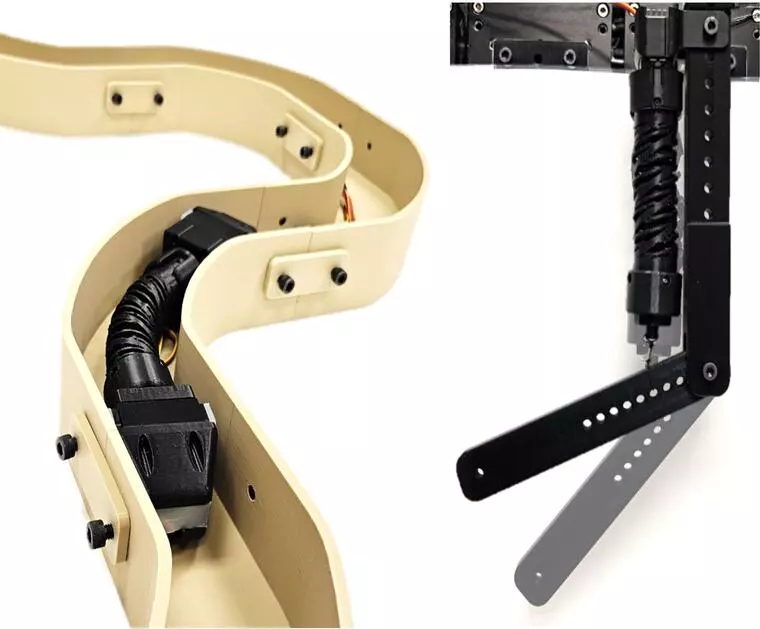Northwestern University engineers have developed a pioneering low-cost artificial actuator that moves by expanding and contracting just like a human muscle. The breakthrough allows for the creation of simplified, low-cost devices, making robots more capable and safer for human interaction.
“Roboticists have been motivated by a long-standing goal to make robots safer,” Dr. Ryan Truby, a professor of materials science and engineering at Northwestern University and study co-author, said in a statement. “If a soft robot hit a person, it would not hurt nearly as much as getting hit with a rigid, hard robot. Our actuator could be used in robots that are more practical for human-centric environments.”
In a paper just published in the journal Advanced Intelligent Systems, Dr. Truby and his colleagues at Northwestern showcased the capabilities of their new actuator. The device, which converts energy into physical movements, was verified by creating a cylindrical, “worm-like” soft robot and an artificial bicep.
The cylindrical robot adeptly navigated the tight curves of a narrow, pipe-like environment, while the artificial bicep successfully lifted a 500-gram weight 5,000 times without failure. Constructed using a standard rubber and a 3D printer, the materials for these robots cost around $3, excluding the motor, making them significantly cheaper than traditional rigid actuators.
The development of this actuator marks a significant leap in robotics, shifting from rigid actuators to more flexible, muscle-like structures. The research team says they were inspired by human muscles’ natural contraction and stiffening properties.
“How do you make materials that can move like a muscle?” Dr. Truby asked. “If we can do that, then we can make robots that behave and move like living organisms.”
To achieve this, researchers 3D-printed cylindrical structures called “handed shearing auxetics” (HSAs) using thermoplastic polyurethane, a type of rubber commonly found in cell phone cases. This material choice made the actuators soft yet durable, overcoming previous rigidity and high-cost limitations.
In earlier versions, actuators made from HSAs required multiple motors to function effectively, complicating their design and reducing flexibility. However, Northwestern engineers simplified the process by incorporating soft, extendable rubber bellows that acted like a rotating shaft. This innovation allowed a single servo motor to twist and extend the HSA, mimicking the muscle-like movement more easily and efficiently.
The compact cylindrical, “worm-like robot,” measuring just 26 centimeters in length, could crawl both forward and backward at a speed of over 32 centimeters per minute.
Engineers highlighted that both the worm-like robot and the artificial bicep exhibited increased stiffness when the actuator was fully extended. This stiffening property represents an advancement over previous soft robots, which lacked this capability.
The potential applications for these soft actuators are vast and transformative. One immediate benefit is the enhanced safety of robots operating in human environments. Unlike traditional rigid robots, which pose injury risks, soft robots can interact more safely with people, making them ideal for roles in healthcare, elder care, and service industries.
In industrial settings, these flexible actuators could lead to the development of more adaptable robotic arms capable of handling delicate tasks that require a gentle touch. For instance, in assembly lines, such robots could manage fragile components without damaging them, improving efficiency and reducing waste.
The healthcare sector stands to gain significantly from this technology. Soft robots equipped with these actuators could assist in surgeries, providing precise movements without the risk of causing unintentional harm. Additionally, they could be used in physical therapy, offering customizable resistance and support for patients undergoing rehabilitation.
These new actuators’ simplicity and low cost also open up possibilities for educational purposes. Schools and universities could incorporate soft robotics into their curricula, providing hands-on experience with cutting-edge technology without the financial burden typically associated with advanced robotics.
This breakthrough paves the way for further research and development in bioinspired robotics, potentially leading to innovations that blend seamlessly with natural environments and human activities.
Moreover, the unique property of these actuators, which stiffen when fully extended, adds another layer of functionality previously missing in soft robotics. This characteristic mirrors human muscles, which tighten and stiffen to perform tasks, offering enhanced performance and reliability in various applications.
“If you have ever twisted the lid off a jar, for example, you know your muscles tighten and get stiffer to transmit force. That’s how your muscles help your body do work,” Dr. Truby explained. “This has been an overlooked feature in soft robotics. Many soft actuators get softer when in use, but our flexible actuators get stiffer as they operate.”
The research, supported by the Office of Naval Research and Northwestern’s Center for Engineering and Sustainability Resilience, highlights the latest example of interdisciplinary collaboration between the natural sciences and engineering to advance next-generation technologies.
Other revolutionary technologies influenced by nature include recent breakthroughs in nanorobots and the development of the world’s first functional true ornithopter, a dexterous-winged unmanned aircraft capable of flying and perching just like a bird.
Engineers believe their breakthrough actuator lays the groundwork for further exploration into more complex and capable robotic systems. Future explorations could focus on enhancing the capabilities of their actuators by developing computational methods to optimize torque transmission and force output. Identifying new materials and designs could also expand the selection space for HSAs and improve the fatigue life of components.
“Given the new capabilities our actuators introduce for soft robotics, we anticipate this work will encourage the broader adoption and use of motorized HSAs as electrically driven soft robotic actuators,” researchers conclude.
As Dr. Truby notes, “Robots that can move like living organisms are going to enable us to think about robots performing tasks that conventional robots can’t do.”
Tim McMillan is a retired law enforcement executive, investigative reporter and co-founder of The Debrief. His writing typically focuses on defense, national security, the Intelligence Community and topics related to psychology. You can follow Tim on Twitter: @LtTimMcMillan. Tim can be reached by email: tim@thedebrief.org or through encrypted email: LtTimMcMillan@protonmail.com

